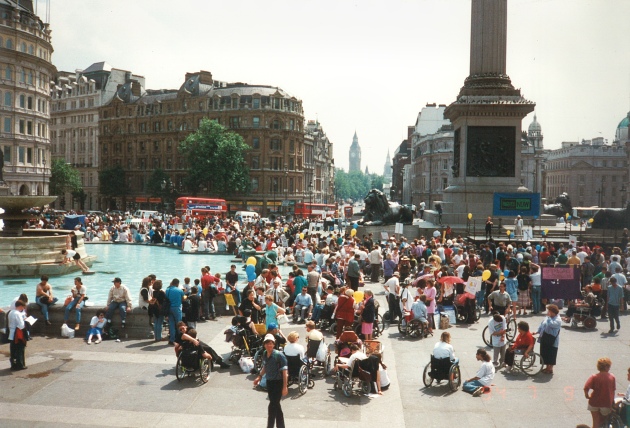PHM has been working with Scope to collect campaigning material relating to the campaign for the Disability Discrimination Act. Here their Campaign Officer, Tom Hayes, writes about the success of the project so far.
Nelson Mandela is known the world over for his impressive fight against racial segregation in South Africa. Helped by a recent blockbuster film, Britain’s women’s suffrage movement is better known among people today. Whether projected onto big screens or taught in classrooms, similar civil rights fights from Selma to Stonewall are well-known.
Other equality campaigns have been wholly forgotten, however. Twenty years ago this month, Parliament finally passed a law to ban discrimination against disabled people. This change would never have happened without the fierce campaigning of disabled people.

Rights Now! rally, Trafalgar Square. Copyright Scope
In their thousands, disabled people gridlocked cities up and down the country, throwing themselves from their wheelchairs and chaining themselves to buses. Their message was clear: activists wanted rights. Not tomorrow or in a year, but, as their campaign’s name demonstrated: Rights Now!
For the first time, disabled people joined together, discovered they were not isolated and alone, and decisively smashed society’s flawed view of disability as something requiring pity not rights.
The law passed twenty years ago – the Disability Discrimination Act – fell short of the civil rights Act that so many disabled people campaigned for. But the campaign itself was life-changing for so many and challenged society’s stereotypes and negative attitudes.
Many of the leading disabled campaigners drew inspiration from the fights against Apartheid and for the vote for women.
The suffragette Sylvia Pankhurst is the only person that one of today’s leading disabled campaigners and a civil rights veteran, Baroness Jane Campbell, says she would be if she could travel back in time.
Many Rights Now! members moved into disability rights campaigning from the anti-Apartheid movement because they despised the injustice of segregation wherever they saw it.
However, in sharp distinction to the equality campaigners who inspired them, Baroness Campbell and others have a hidden history of campaigning. The campaign which took so much of the media spotlight in 1994 and 1995 has been entirely forgotten today.
Young disabled people – even those who campaign for change in their communities today –have been shocked to find their rights have not always been there and needed a fight to bring about.
That’s why Scope has been celebrating the civil rights activists who fought for equality and brought about the change that happened twenty years ago this month. We’re proud to be working closely with the People’s History Museum to preserve a past in danger of disappearing. Together we have appealed to campaigners to rummage through their attics and find mementoes.
In the next few weeks, we’ll be sharing some of the treasures that leading campaigners have shared with us as a direct result of our joint public appeal for donations. Until that time we will be sharing some stories of the civil rights campaign, as told by the leading activists themselves.
The campaigns which inspired disabled activists twenty years ago are honoured every day by the People’s History Museum in the galleries that are seen annually by tens of thousands of visitors.
Together we want as many people to see disabled people’s campaigning, right alongside better-known movements, so that their campaigning can inspire today’s activists as much as others do.
Disabled people’s campaigning has been central to our national march towards equality. Scope can have no better partner to honour this campaign than the People’s History Museum – the nation’s own museum of democracy and equality.








 We are delighted that we will be hosting the
We are delighted that we will be hosting the  We are delighted have been donated a beautiful new banner for our collection. The International Women’s Day banner was created in 1988 by Blackburn Youth Service girls’ group. Paula Kaniuk, who kindly donated the banner, explained that the unusual shape of the banner was inspired by the idea of the globe, with two women’s hands joining across the globe.
We are delighted have been donated a beautiful new banner for our collection. The International Women’s Day banner was created in 1988 by Blackburn Youth Service girls’ group. Paula Kaniuk, who kindly donated the banner, explained that the unusual shape of the banner was inspired by the idea of the globe, with two women’s hands joining across the globe. It then went on display in a youth club called the Fuse Box, which was an old electricity station. It was displayed until 2011 when the building was pulled down and came back to Paula.
It then went on display in a youth club called the Fuse Box, which was an old electricity station. It was displayed until 2011 when the building was pulled down and came back to Paula. Regular readers of our blog will have seen that the People’s History Museum has been planning a tour and we are excited to announce our next stop… Rochdale! On Sat 8th February 2014 come and find us – rain or shine – at the bottom of Yorkshire Street in Rochdale between 10:30am and 12pm. We will be joining the Rochdale and Litttleborough Peace Group at their regular stall and want you to come and get involved in our exciting Play Your Part project.
Regular readers of our blog will have seen that the People’s History Museum has been planning a tour and we are excited to announce our next stop… Rochdale! On Sat 8th February 2014 come and find us – rain or shine – at the bottom of Yorkshire Street in Rochdale between 10:30am and 12pm. We will be joining the Rochdale and Litttleborough Peace Group at their regular stall and want you to come and get involved in our exciting Play Your Part project. On the first leg of our
On the first leg of our 

